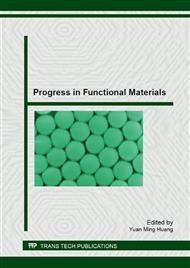[1]
A. Inoue, A. Kato, T. Zhang, S.G. Kim, T. Masumoto, Mater. Trans. JIM. Mg-Cu-Y amorphous alloys with high mechanical strengths produced by a metallic mold casting method, 32 (1991) 609-614.
DOI: 10.2320/matertrans1989.32.609
Google Scholar
[2]
A. Peker, W.L. Johnson, A highly processable metallic glass: Zr41.2Ti13.8Cu12.5Ni10.0Be22.5, Appl. Phys. Lett. 63 (1993) 2342-2344.
DOI: 10.1063/1.110520
Google Scholar
[3]
H. Fu, M. S. Guo, H. J. Yu, X.T. Zu, Large relative cooling power of Gd52.5Co16.5Al31 magnetic bulk metallic glass, J. Magn. Magn. Mater. 321 (2009) 3342-3345.
DOI: 10.1016/j.jmmm.2009.06.021
Google Scholar
[4]
V.K. Pecharsky, K.A. Gschneidner Jr., Tunable magnetic regenerator alloys with a giant magnetocaloric effect for magnetic refrigeration from ~20 to ~290K, Appl. Phys. Lett. 70 (1997) 3299-3301.
DOI: 10.1063/1.119206
Google Scholar
[5]
S.S. Fang, X.S. Xiao, L. Xia, W.H. Li, Y.D. Dong, Relationship between the widths of supercooled liquid regions and bond parameters of Mg-based bulk metallic glasses, J. Non-Cryst. Solids, 321 (2003) 120-125.
DOI: 10.1016/s0022-3093(03)00155-8
Google Scholar
[6]
Q. Luo, D.Q. Zhao, M.X. Pan, W.H. Wang, Magnetocaloric effect in Gd-based bulk metallic glasses, Appl. Phys. Lett. 89 (2006) 081914.
DOI: 10.1063/1.2338770
Google Scholar
[7]
T.D. Shen, R.B. Schwarz, J.Y. Coulter, J.D. Thompson, Magnetocaloric effect in bulk amorphous Pd40Ni22.5Fe17.5P20 alloy, J. Appl. Phys. 91 (2002) 5240-5245.
DOI: 10.1063/1.1456957
Google Scholar
[8]
J. Guo, X.F. Bian, Q.G. Meng, Y. Zhao, S.H. Wang, C.D. Wang, T.B. Li, Glass-forming ability and fragility of RE55Al25Co20 (RE = Ce, Pr, Nd, Sm, Gd) alloys, Scripta Mater. 55 (2006) 1027-1030.
DOI: 10.1016/j.scriptamat.2006.08.021
Google Scholar
[9]
Z.P. Lu, C.T. Liu, A new glass-forming ability criterion for bulk metallic glasses, Acta Mater. 50 (2002) 3501-3512.
DOI: 10.1016/s1359-6454(02)00166-0
Google Scholar
[10]
M.J. Starink, The determination of activation energy from liner heating rate experiments: a comparison of the accuracy of isoconversion methods, Thermochemica Acta, 404 (2003) 163-176.
DOI: 10.1016/s0040-6031(03)00144-8
Google Scholar


